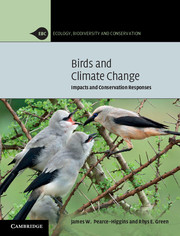Book contents
- Frontmatter
- Dedication
- Contents
- Foreword
- Acknowledgements
- 1 Birds and climate change
- Part I Impacts
- Part II Conservation responses
- 6 Using models to predict the effects of climate change on birds
- 7 Conservation in a changing climate
- 8 Effects of climate change mitigation on birds
- 9 Overall conclusions
- References
- Index
8 - Effects of climate change mitigation on birds
Published online by Cambridge University Press: 05 June 2014
- Frontmatter
- Dedication
- Contents
- Foreword
- Acknowledgements
- 1 Birds and climate change
- Part I Impacts
- Part II Conservation responses
- 6 Using models to predict the effects of climate change on birds
- 7 Conservation in a changing climate
- 8 Effects of climate change mitigation on birds
- 9 Overall conclusions
- References
- Index
Summary
Introduction
So far in this book we have described the mechanisms by which climate change affects birds, reviewed potential future changes in their distribution and abundance caused by climate change and discussed the implications of these for conservation. It is clear that as the magnitude of warming increases, so will the likely severity of impacts on bird populations. The number of projected bird extinctions is modelled to increase by about 1.6 times from a 2 °C to 4 °C global warming scenario, and differ by approximately 2.5 times between a 2 °C and 6 °C scenario (Box 6.5), when it is estimated one-quarter of global bird species would be at risk of being committed to extinction as a result of climate change (Section 6.8.2). Clearly, addressing the causes of climate change will be an important way of reducing the likely detrimental impacts of climate warming on birds (Warren et al. 2013). However, attempts to do this through the reduction of greenhouse gas emissions or the removal of gases from the atmosphere (termed climate change mitigation) may also have a detrimental effect on bird populations.
The principal sources of anthropogenic greenhouse gas emissions are carbon dioxide from the burning of fossil fuels (coal, oil and gas), deforestation and other land use changes leading to the burning or decay of plant material, release of methane from refuse in landfill sites, gut fermentation by ruminant livestock and the farming of rice, and release of nitrous oxide caused by the use of fertilizers in agriculture (Section 1.5). Changes in the ways in which energy is obtained and used, the protection of forests and peatlands and changes in farming practice are therefore the main methods being considered for climate change mitigation. In addition, there might be ways in which the environment could be artificially adapted to remove greenhouse gases from the atmosphere at higher rates. All of these mitigation measures will change the natural environment and could therefore affect bird populations. In this chapter we examine some of these potential effects and assess ways in which potential adverse impacts of mitigation may be reduced, focussing particularly on renewable energy generation.
- Type
- Chapter
- Information
- Birds and Climate ChangeImpacts and Conservation Responses, pp. 308 - 358Publisher: Cambridge University PressPrint publication year: 2014
- 1
- Cited by



